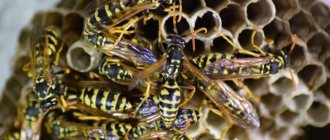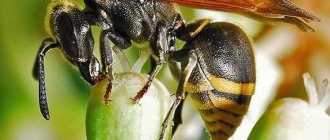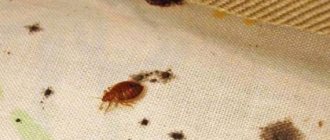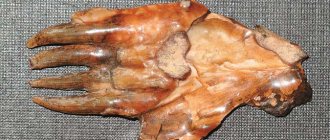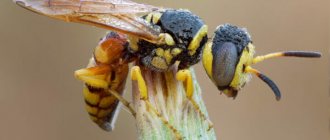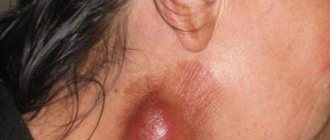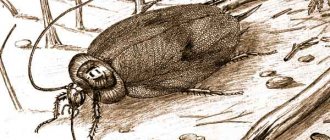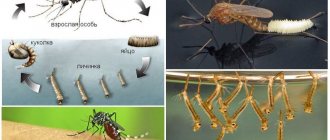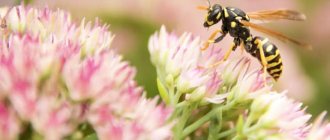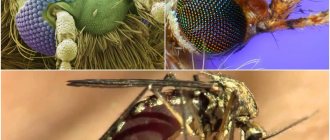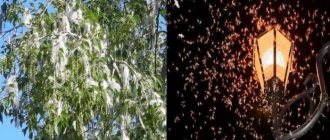Construction process
A fertilized young female, the queen, chooses a place for her future home.
It glues an adhesive substance extracted from wood to the base, stretches it, and a leg is formed, on which the first honeycombs are subsequently built. Initially there are very few of them; they are necessary for growing and feeding the larvae. The process begins in early spring. Within a month, a new generation of worker wasps appears and begins active construction of the hive. The uterus sheds the powers of an architect and is engaged only in the reproduction of offspring.
- The hornet's nest is being built at an accelerated pace, since the number of members of the large family is rapidly increasing. New cells appear at the base of the handle, which overlap each other to form a honeycomb.
- As the number of cells increases, a bowl-shaped structure begins to emerge. Over time, it increases in depth, expands on all sides, and becomes like a sphere. There is a hole in the center for entry.
- The construction of the second part of the sphere gradually begins. The number of cells decreases towards the top. The finished large wasp nest resembles a cocoon.
After construction is completed, the queen removes several layers of internal cells in the first sphere. As the wasps make the honeycombs wider, the space inside is freed up. The outer shell of the nest is thin and papery. It is formed from long, thin, elastic plates. In most cases, recycled building material is used, which is taken after the inner layers of the hive have been destroyed.
Construction material
The finished wasp nest is nothing short of impressive. From the outside it looks like a smooth, oval-shaped egg. Inside, numerous honeycombs are found, arranged in a certain way. The building material resembles ancient parchment. Mostly gray, brownish in color. Because of the way wasps build their nests, they are called paper wasps. The family is one of the most numerous and includes species and subspecies.
What wasps make nests from and how building materials are obtained also deserves respect. The insect lands on wood, spits out a certain amount of its own secretion, under the influence of which the upper tissues of the tree bark liquefy. The wasp grabs the top layer with its powerful jaws and pulls it towards itself, as if scraping it off. When she has the amount she needs, she goes to a place where other relatives are making a hive.
Having arrived at the right place, the wasp once again carefully chews the building material with its jaws. Under the influence of saliva, the wood becomes sticky, stringy, gray or brown, depending on what tree it was extracted from. The wasp spits the finished building material onto the already formed honeycombs, again stretches it with its jaws, giving its structure an oval shape. This is how a new thin partition appears.
The wasp obtains woody elements from the bark of various trees, stumps, fences, and wooden outbuildings. If there is not enough building material or the queen finds a place suitable for raising larvae, the wasps build a nest underground, in old stumps, hollows, left by bird houses.
Repellents
House bugs are afraid of certain aromas; they detect them using neurons located on the hairs. Repellent plants include the following herbs:
- Sagebrush. This plant is the most effective and efficient. Wormwood is a popular way to help repel bedbugs; the herb is inexpensive and is quite easy to use. You can pick the plant yourself or buy it at the pharmacy. If the scaring period occurs in the summer, it is better to pick fresh wormwood. Bed bugs do not like the smell of this plant, so it is necessary to spread the grass in different places: under baseboards, beds, mattresses, rugs, in cabinets, bedside tables. It definitely won’t help get rid of bedbugs, although it will scare them away for a while. But these bloodsuckers will still leave offspring. The plant has no effect on the eggs, and over time it loses its effectiveness. But it is a good preventive measure and will help people living in a house that has these bloodsuckers to alleviate their suffering for a certain period of time. If there are no bed bugs in the apartment, but the neighbors have them, it is recommended to place wormwood at the threshold, in the ventilation grilles. This way, the neighbor’s problem will not be “transferred” to you. Before laying out the grass in the house, you need to do a wet cleaning and wash the bed.
- Tansy. When asked what bed bugs are afraid of, you can find many rave reviews regarding this herb. Some may be lucky enough to get rid of these insects for a while, but not for long. These cute yellow flowers cannot solve the problem globally. Yes, insects are afraid of their smell and will not cause unpleasant moments to the owners of the house for some time. Insects are afraid of this grass, just like wormwood. It is recommended to place it under mattresses, beds, sofas, and baseboards. You can use tansy decoction. To do this, boil it in water and, after cooling, spray it throughout the apartment. The decoction and tansy herb have no effect on eggs, but insects are afraid of it.
- Air. The rather pungent smell of calamus can repel house bugs. You can buy it at the pharmacy, it is sold in powder form. You should scatter the powder under mattresses, beds, baseboards, and in the corners of rooms. Calamus is completely safe for people and animals. It is added to infusions and decoctions.
- Chamomile. Previously, the drug pyrethrum was made on its basis. Nowadays it is practically not on sale, so an alternative is pharmaceutical medicinal chamomile. Bed bugs are very afraid of its smell. This plant is completely safe and has a calming effect on people. It is recommended to use chamomile essential oil. You should leave a few drops on the night light.
- Bay leaf. A plant that is completely safe for the health of households and is often used in cooking. But bed bugs cannot stand the smell. Leaves can be laid out in unlimited quantities. Also, infusions are prepared based on them, added to water and washed floors.
Herbs can provide effective help if there are a small number of insects in the house. Despite the fact that the herbs can smell strongly, insects are able to overcome their fear, as it is overcome by hunger.
Repeller
You can also try purchasing a bedbug repeller. The manufacturer gives 100% effectiveness. It is safe for people and pets. Judging by the reviews available on the Internet, the product has proven itself to be excellent.
What does a wasp's nest look like from the inside?
The interior structure is funny, thoughtful, surprising. The honeycombs are placed vertically in unique floors, after every 3-6 rows there is free space. It is also surprising that all the cells are directed downward in one direction. A cross-sectional photo of a wasp nest can be seen below. You can cut the hive only if you are absolutely sure that it is empty.
Cross-section of a wasp's nest
The structure of the hive is thought out to the smallest detail. The inner part is always the most durable and reliable. Honeycombs are not built from a thin sticky secretion similar to paper, but from wood chips, in a size that the working individuals can carry and attach. Inside the wasp nest there are chambers for larvae, a room for the queen, food storage rooms and much more.
Nest growth
After making the base of the nest, the female flies in search of building material. Having found suitable wood, she releases a drop of saliva onto it, which softens the wood fibers. The wasp scrapes off the pliable wood using its powerful jaws and rolls it into a small ball with its front paws. Moving along a woody surface like a precise mechanism, the wasp leaves behind a clearly visible trail.
The female carries the resulting lumps to the construction site. There she chews the wood again, mixing it with saliva and secretions of special glands. From the material, which becomes completely soft, the wasp makes a paper plate, carefully and evenly kneading the parchment lump with its front paws. The wasp attaches the resulting piece of paper to the base of the nest and flies for a new portion of material.
While building the frame, the female simultaneously lays eggs and feeds the growing larvae. The newly matured wasps join the construction. As soon as the female manages to raise 10 new wasps, she stops building and from that time on only lays eggs, then her children build the nest.
How to find a wasp's nest
Finding insect habitats is not always easy. This is due to the fact that wasp hives can be located in a variety of places:
- underground in empty mouse holes;
- on branches and in the hollows of old trees;
- in basements and attics of residential premises.
Only a thorough inspection of the utility rooms located in the house and apartment will help you find a hive.
Wasps are in constant search of food for the larvae growing in their nest. The desire to feast on sugary substances attracts insects to people’s homes, especially during the period of making jam. They do not disdain meat scraps from human food.
If it is not possible to determine the presence of a nest visually, and the presence of insects bothers you, then you should leave fruit or pieces of meat in a visible place. By observing where the uninvited guests take their prey, it will most likely be possible to determine their permanent location.
The size of the constructed hive can range from the diameter of a tennis ball to a basketball, and in some cases larger. Regardless of the location, the wasp hive is built in the form of a horizontal structure, the cells of which face downward with their entrances.
Important! When trying to destroy a wasp's nest, do not stand directly under it, otherwise an angry swarm of wasps will fall right on the head of its offender. If during the search a wasp nest was discovered in the initial stage of construction, then measures must be taken to eliminate it as quickly as possible
This is due to the very fast pace of work of the insect. Sometimes a new house grows right before the eyes of people amazed at the speed of its appearance.
If during the search a wasp nest was discovered in the initial stage of construction, then measures must be taken to eliminate it as quickly as possible. This is due to the very fast pace of work of the insect. Sometimes a new house grows right before the eyes of people amazed at the speed of its appearance.
Wasps - masters of paperwork
Among all the species that inhabit our planet, wasps are characterized as the most skilled paper craftsmen.
True, not all wasps build their magnificent houses from paper pulp, which is obtained by chewing wood. However, the well-known striped robbers, which many people with a sweet tooth have been afraid of since childhood, belong specifically to the family of so-called paper wasps, or more precisely to two biological families, similar in biological characteristics - vespins and polystines.
The wasps of these two families lead a social lifestyle, which forces them to build rather large nests that would provide shelter to all members of the wasp community. At the same time, the multi-apartment wasp house must be dry and warm, because, like all hymenoptera, wasps are afraid of high humidity, which weighs down their transparent porches and does not allow them to take off.
Various methods of destroying a nest
Option 1
You need to start fighting the dominance of hornets with the onset of cold weather (late autumn - early winter).
- Remove all old nests.
- Seal cracks and holes.
- Adjust the doors so that they close tightly.
- Continue activities in the spring, try to find a nest.
Attention! All pest control work is carried out in special protective clothing. It consists of a hat with a veil covering the face, neck, and head
A jumpsuit or jacket and pants are worn that completely cover all other parts of the body. Boots and gloves complete the outfit.
Option #2
Hornets' nest can be found in the basement
- Since April, experienced beekeepers begin to monitor the appearance of large, sexually mature females on the site. Having chosen a place, the queens begin to sculpt the first honeycombs. This is the moment that cannot be missed. You need to immediately, armed with a shovel and a puller, knock down a small cocoon the size of a walnut and crush it (or burn it) with all its contents.
- At dusk, treat the nest with foam from a carbon dioxide fire extinguisher so that all the honeycombs get wet and their inhabitants freeze. Then remove the house mechanically.
- If you find a nest in the area hanging from the branches, take a plastic bag (you can use it for garbage). Spread it just under the hanging house. Use tree pruning shears attached to a long pole or otherwise trim the cocoon. Immediately direct a stream of Dichlorvos, Executioner, Get or another insecticide against flying insects at it. Quickly tie the bag until the poisons evaporate, then burn.
Option #3
Nest in the attic - hidden in a hard to reach place
Don't know how to destroy a hornet nest in your attic or shed? Everything is simpler than it seems in reality:
- Hang a bucket full of boiling water or kerosene diluted in water under the roof. The container is suspended so that the cocoon is completely immersed in the solution. Support the bucket with a makeshift pedestal or stepladder. Wait a day. Remove the limp nest.
- Buy 2 or 3 cans of Karbofos, Dichlorvos, Executioner or another product that specifically affects flying insects (specifically hornets). From a safe distance, direct the jet at the structure and carefully treat the house. Then inject the insecticide inside through the bottom passage. Leave for a day. To enhance the effect, smoke the hornets that managed to fly out before treatment. Check for live specimens. If necessary, repeat the treatment. Get rid of the nest.
- You can seal the honeycombs with polyurethane foam.
- First spray the nest hanging from the branches with diesel fuel or gasoline from a spray bottle, then set it on fire.
- A discovered hornet nest in the ground is poured with boiling water. As an option, build a fire in this place or, after digging out the entrance, burn out the insects with a blowtorch.
- Also, kerosene or gasoline is poured into the “underground house” at night and then set on fire.
- Hornets that have settled in tree hollows are poisoned with an insecticide. Often, diluted poison against Colorado potato beetles is used for this. After this, the hole in the hollow is covered with cement mortar or putty.
If independent measures do not lead to effective results, you need to contact a pest control service. This should be done immediately if a child is bitten by a hornet.
Wasps wintering place
Looking at the internal and external structures of the wasp’s nest, it seems that the family will spend more than one year there. Similar to what happens in ants. However, large buildings and complex architectural structures play the role of a summer house.
With the onset of autumn, young sexually mature females mate and begin to look for a suitable place for wintering - cracks in the wall, wooden buildings, tree bark, old stumps, abandoned hollows. Over time, metabolic processes slow down, the female falls into suspended animation and sleeps until the beginning of spring. From the first warm days he begins to build a new hive.
Wasp nestsHow long do wasps live in a nest?
After the wasps have built a nest, the life cycle of the wasp family lasts one summer. The life of the hive, which began in the spring, reaches its climax by mid-summer and continues while construction is underway. By the beginning of autumn, all life processes calm down and stop. The established order is unchanged and requires annual new buildings.
Last year's hives are not relevant for a wasp swarm, but if the location chosen for construction is well located, the insects will build another home within walking distance of last year's house.
Important! Wasps can return to their favorite places even after their home is destroyed. Therefore, it is necessary to treat the area where the hive is located with special substances designed to combat and destroy these insects.
Where do wasps nest?
The young queen chooses a place where there is building material and food supplies in close proximity. In the wild, insects make their homes on trees with a large, dense crown, under old stumps, and abandoned bird houses. However, there are cases of a hive being built under a stone, on a blade of grass. Where the young female considers it necessary to build housing, the working individuals will continue the construction.
Insects can build hives near humans - under the roof of a house, outbuildings, in an attic, on a balcony, or live in a garden, yard, vegetable garden, or vineyard. And also on trees, bushes, old stumps on the site. If in the wild, wasps bring a lot of benefits, destroying harmful insects, in the territory of a garden, summer cottage, yard, they become real pests. Therefore, a person tries to get rid of wasp nests on a balcony, in a country house, or in a vineyard.
Appearance
What do wasps make their nest from? Bees produce wax, thanks to which they build their houses. Wasps do not have such abilities, but they have jaws that can detach pieces of wood and chew them. With the help of their saliva secreted during this process, they process this material into a thin plate, resembling paper in appearance. From the resulting raw materials, the wasps already form their home, first constructing honeycomb cells, and then wrapping them in a wrapper resembling a cocoon. To see how insects make a nest, you need to watch them for several days.
What does a wasp's nest look like? At the first stages, its appearance is similar to a honeycomb, and then they become overgrown with numerous walls and are more reminiscent of a cocoon with a hole from which they can fly out and fly in. What else do they build a hive from? What materials can they use? Wasps can use not only pieces of wood, but also dry leaves, transforming plant stems into the walls of their house.
Do wasps die after being stung?
Many people believe that a wasp and a bee are insects that have no differences. But this is completely wrong. Not only do they live different lives, but they also attack differently. Here the question arises: who dies after a sting: a bee or a wasp.
The main weapon of wasps is the sting, which is a modified oviposition. During quiet times it is hidden inside. As soon as the insect senses danger, the muscles push it out.
When attacking their prey, wasps pierce the skin with their sting and inject poison. Does a wasp die after being stung? No. Unlike a bee, a wasp can sting more than once. Moreover, after the attack, they calmly continue their life activities. When a predator senses danger, it attacks the prey, then pulls out its sting and flies away. This is due to the smoothness of the sting itself.
Types of wasps
All types of wasps are conventionally divided into solitary and collective living. This makes these insects very convenient objects for study by biologists, who have the opportunity to trace in great detail the transition of individuals from a solitary lifestyle to a colonial, and then to a caste family structure.
In addition, wasps are distinguished by territorial preferences - the choice of a place to build a nest.
- Road wasp - it prefers to dig small holes in the ground and builds its nest there. She lays her eggs directly on a victim previously paralyzed by a sting - this could be some kind of insect or spider, whose body subsequently becomes food for the hatched larvae.
- Paper wasps are common striped insects that can live both near humans and far from residential buildings. Their nest is a rather curious structure - the fact is that for construction they use a material that is very similar to the thinnest paper, and they make it themselves, mixing wood dust with their own saliva.
- Wild wasps lead a slightly different lifestyle. They build their nests away from human habitation. However, it is worth noting that this name may well hide the paper wasps described above, which often settle in people’s houses only because there is an abundance of food there.
- The forest wasp got its name due to the fact that to create a nest it selects hollows or starts construction directly on a tree trunk - on a peeled piece of bark. Often their nests are also found in small rock caves and under fallen trees.
What do wasps make their nests from?
Hornets nest
Note! Unlike bees, wasps do not have the ability to produce wax, so they build a home from small pieces of wood they come across.
Nature compensated for the inability to secrete wax by giving the wasps jaws. With their help, insects scrape pieces of rotten wood, and then glue the resulting mass with the liquid produced during chewing. Wood chips, bark and even sawdust are used. The construction material obtained in this way can be compared in appearance to wrapping paper. For this skill, the insects received the name “paper wasps.”
The walls of the internal cells have a denser and smoother structure. The layers of the outer sphere of the structure under construction look quite loose. Wasps that live in the tropics use everything they find to create their hives: limestone pieces, clay grains of sand, and, if necessary, manure.
There are several thousand species of wasps, each of which adapts to environmental conditions in its own way. Habitat features greatly influence what wasps use to make a hive.
What do wasps make their nests from?
The largest species of wasps, hornets, use young tree bark for construction. From the outside, a hornet hive looks like a large bucket, and in cross-section, the cells of the nest are colored yellow-brown, sandy or brown.
Precautions and Recommendations
Whatever decision you choose regarding how to remove a wasp nest, you should remember precautions. If the question is how to remove these pests in the spring, when the colony is still small and consists of several individuals, this will be easier to do than in the summer, when their colony will number several thousand
In the fall, when cold weather sets in, these insects leave their home; you can safely throw it out - it will be empty
Handle dead wasps with care too. Their sting, even after death, remains capable of piercing human skin
Wear protective clothing that is not tight to the body, protect the face, skin of the hands, feet - then proceed to action. Treat the location of the cocoon with poison - this is a warning against the return of surviving wasps.
Chemical disposal
If you find a colony of wasps in your garden plot or you need to remove them from the attic, and other gentle methods are not so effective, then you can use drastic methods - use various chemicals
It doesn’t matter how many wasps there are in the colony, a few or several thousand, you need to remove their home to protect yourself and your family from their bites
When using substances that are dangerous not only to insects, but also affect human well-being, it is necessary to take some safety measures. You need special clothing, rubber gloves, a respirator, and a gauze bandage. If the cocoon is located indoors, ventilate it after processing. Do not forget that no matter what method is chosen to safely remove the hive from the house, all actions to neutralize it must be carried out late in the evening or at night.
Lures
What bait should be made from to poison all the inhabitants of the wasp hive? When making a trap, you can add a solution of boric acid to aromatic, sweet baits at the rate of 10 grams per liter. Even if she tries this mixture, gets out of the trap and flies away, she will not live for a long time. Poison for these types of traps is commercially available. It does not have a strong odor and can be sold in the form of gels or powder.
Drugs
How to quickly remove a wasp nest from the attic? This can only be done after the complete destruction of its inhabitants. You can force them to leave their home, or you can use drugs that will lead to the death of the entire family. They are sold in various forms: liquid and powder.
How to effectively remove a wasp hive in your garden? To do this, dilute the drug with water in the proportions as indicated in the instructions and place this solution in a special sprayer (used for spraying trees) and, following safety precautions, apply the product to the cocoon.
Sprays and aerosols
When fighting a hive, you can use special sprays, aerosols, which can be found in stores that sell chemicals for pest control. Having purchased such a drug, go to the hive, insert the sprayer into the hole from which the wasps fly out, and begin to inject the chemical inside.
Some individuals can get out. They should be sprayed, not forgetting about a safe distance and protective equipment.
Liquids
How to get rid of a wasp hive yourself? This will not be difficult if you use special chemical liquids that are sold in concentrated form and require dilution with water. Even if there is a wasp nest on the balcony, you can apply it using sprayers. Such poisons can be potent and dangerous to the health of others. After applying them, you need to ventilate the room.
Insecticides for wasp control
Most modern insecticides successfully kill wasps
It is important to take into account only a few nuances. First, make sure that poisoned baits are not too attractive to harmless pollinating insects and your pets.
Secondly, it is necessary to destroy not only adult wasps, but also larvae and the queen, which can be difficult, because wasps love to build their homes in hard-to-reach places.
Wasps can settle not only in attics and plants, but also in the ground
The preparations used for traps, despite their toxicity, do not have a strong odor and are available in various forms, for example, in the form of powders, gels or glue for insects. Preparations for killing wasps in a nest are usually produced in the form of sprays or concentrates for subsequent dilution and spraying of the wasp's home. They usually successfully cope with both adult wasps and wasp larvae.
The most well-known of the time-tested insecticides for controlling wasps is boric acid. It is characterized by the absence of a pungent odor and can be successfully used to create poisonous baits.
Another “veteran” is the well-known Dichlorvos. Until recently, it was one of the popular drugs that was used against a huge number of insects. But at the moment it is prohibited for use in the same way as Karbofos, due to its high toxicity.
Delta Zone is a well-known concentrated product with a weak odor that does not repel wasps, and therefore can be successfully used as part of poisonous baits.
Get is a modern insecticide without a pronounced odor. Suitable for bait and for destroying wasp nests, but also works on other insects.
OtOc is a ready-to-use product that already contains insecticides, sugar and flavoring to attract wasps. The manufacturer claims that OtOS is safe for bees.
Among the aerosol preparations that destroy wasps, Bros, Help, Super Cobra, Moskitol, Death to Pests No. 2, spray against flies and wasps Clean House, gel Wasp, as well as traps Taiga and Argus Garden received good reviews.
If you are bitten by a wasp while processing a nest, you should not kill it, as this may provoke aggressive behavior of the entire swarm.
Numerous insect control adhesives operate on the same principle: they are applied to cardboard, and then bait is placed on top of them. The disadvantage of glue traps is that they attract different insects and are not able to quickly cope with the entire swarm of wasps.
When wasps leave their nests
Every hive has guard wasps. When danger approaches, they give a special signal, thanks to which a large number of irritated insects instantly emerge from the nest, ready to defend their possessions.
Despite the fact that the wasp's venom does not pose a critical danger to humans, its bite is quite painful. The most powerful and unpleasant bite for humans is a hornet bite.
Important! A distinctive feature of all wasps is the ability to sting several times in a row. Due to its structure, a wasp sting does not get stuck in the skin of a person or animal.
Close proximity to a wasp nest can ruin not only the mood of people living nearby, but also their health. Therefore, having discovered a hive, it is necessary to take decisive measures to destroy it. With quick and precise movements, crush the hive with your hand or, if possible, your foot.
Attention! Having decided to destroy a nest, you need to protect your body, especially your face and hands, with clothing that can protect you from bites.
How wasps build a nest
Construction of the nest occurs in stages:
- Construction begins in the spring. The female, who managed to survive the winter, prepares a place for breeding future offspring. To do this, she constructs several cup-shaped cells. Due to their shallow depth, one egg is laid in each cell. The female is responsible for the life support of the larvae, obtains food for them and carries out feeding.
- As they grow, the larvae increase in size. The female, as necessary, builds walls for the growing offspring. Within a month, a metamorphosis occurs, transforming the egg laid by the uterus into a pupa, which in turn transforms into an adult.
- The first insects to appear are females that are not capable of reproduction and play the role of building maintenance workers. Now they build up the walls of the partitions, creating new cells for eggs, which the female continues to lay. Feeding the growing larvae is also the responsibility of these hard-working, but incapable of procreating insects.
- July is a turning point in the life of the wasp family, living on several floors of a house under construction, filled with cells of different sizes.
- By the end of summer, the largest compartments are occupied by hatched females, awaiting the appearance of males. Wasps of different sexes have external differences: males lack a sting, but have mustaches that are larger than those of females.
- Along with the passing summer months, the life of the male population of the hive, as well as the worker wasps and the old queen, ends. Construction stops.
- During this period, grown-up young females leave their summer home and find cozy and warm crevices in which they will wait for the arrival of spring.
- Next spring, each of the fertilized wasps will become a queen and begin building a new home in which to lay future offspring.
How many wasps in one nest
Depending on the size of the house, a huge number of insects, sometimes numbering in the hundreds of thousands, can comfortably live in it.
Wasps are distinguished by a variety of species of individuals living in interaction in one house. Females, males and working insects have different structures and external differences that are noticeable even to a non-specialist. Each group strictly fulfills the duties prescribed by nature. Differences within one species are called polymorphism, or multiformity. The bulk of the residents are working individuals, which are concentrated around the queen, who continues to lay new eggs.
How many wasps in one nest
